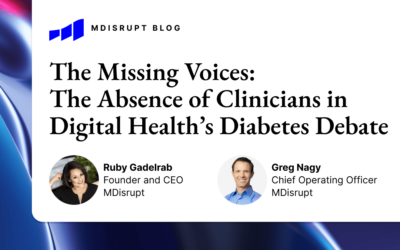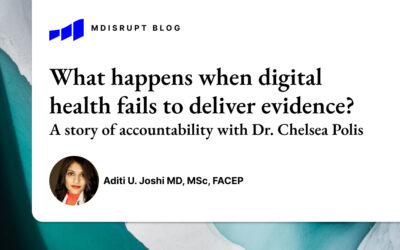
MDisrupt CEO and founder Ruby Gadelrab shares her insights in a recent Clubhouse MedTech interview with Henry Peck. Ruby has worked on the commercial side of biotech, healthcare, and digital health for 24 years. She founded MDisrupt to connect digital health innovators to the healthcare industry experts and scientists they need to responsibly accelerate product development, commercialization, adoption, and scale.
Henry Peck: Let’s talk about 23andMe. What role did you play there and what were the key challenges you were trying to solve for the business?
Ruby Gadelrab: First, some disclaimers—I left 23andMe four years ago. So I’m not speaking on behalf of the company. The opinions are my own as an industry observer.
I was hired at 23andMe just after the FDA had told them they had to temporarily stop selling health products to consumers. My role was to help them figure out some of the non-consumer business models. These included:
- 23andMe for medical professionals. How do we educate and engage medical professionals on genetics and the reports that 23andMe were providing?
- 23andMe for educators. Could a genetic test be used to teach university and medical students about genetics, statistics, and ancestry better than a textbook could?
- 23andMe for research. How could the 23andMe experience be used in a research setting to improve recruitment in population health studies? For example, by giving people interesting data about their ancestry and eventually their health, can we improve recruitment and longer term engagement?
How 23andMe broke new ground
Henry Peck: In your opinion, what makes 23andMe’s product offering so successful and “sticky”?
Ruby Gadelrab: Let’s break this question down into two parts—why is it successful and sticky to consumers, and then secondly why does it have huge potential as a business.
Let’s start with consumer experience. Every aspect of our lives has been digitized through technology. Healthcare is undergoing that same revolution. 23andMe was the first company to work closely with the FDA to create a product that consumers could buy directly themselves that gave them personalized insights from their genetics about their health and ancestry. Over 10 million people bought the product and clearly, ancestry was one of the killer apps, but consumers also had an interest and hunger for health information and trait information.
23andMe made that information really easy and engaging for consumers to understand and interact with. They made the information digestible at an eighth grade literacy level and they explained complex genetics concepts simply enough for people to understand.
23andMe gave consumers the ability to participate in research for causes and diseases that they really care about. During the time I was at 23andMe over 80% of consumers were consenting to research.
Business value
Henry Peck: So what does that mean in terms of value to the business?
Ruby Gadelrab: 23andMe has one of the largest genetic databases in the world, with over 10 million people genotyped and consented to research. An individual genome isn’t really that useful unless it’s paired with phenotype and/or clinical information and aggregated with millions of other genomes so that we can see the patterns and discover new genes that are important for diagnostics and therapeutics.
What’s unique about 23andMe is that the database is recontactable and engaged and the company has the ability to collect additional phenotype data—I believe they currently have over 30K phenotypic surveys completed daily. Effectively, they have built a crowdsourced research platform where you can quickly make novel discoveries which can be applied to building new generations of therapeutics and diagnostics.The value they add to research is clearly recognized by pharma. Drug development is a long and expensive process. That’s because:
- It takes 7-10 years to bring a drug to market.
- 90% of drug candidates fail.
- $2.6B is the average cost of getting a drug successfully to market.
- It’s incredibly difficult to recruit patients into clinical trials and engage them for the life of the trial.
How do we create efficiencies in this process? The theory is, with the combination of genotype/phenotype data and a recontactable database, can you accelerate the pace of novel drug discovery? Find new drug targets and bring them to market faster? 23andMe has a partnership with GSK where they currently have over 30 therapeutic programs in the areas of oncology, cardiovascular disease, immunology, neurology, and metabolic disease, so clearly pharma sees the potential of such an asset.
4 keys to health product success
Henry Peck: Let’s talk about 23andMe’s recent announcement. How do you think this next step will change the company and their business? Any bold predictions for the future of 23andMe?
Ruby Gadelrab: Despite the numbers, the genetics industry is still in its infancy. And it’s still not a routine part of our healthcare system. Our healthcare system as it stands today is neither about health nor about care—it’s actually a reactive sick care system.
One of the few silver linings of the COVID-19 pandemic is that It showcased the huge gaps in our healthcare system that are ready to be addressed by those who are daring enough to try and disrupt it. Effectively, the pandemic pushed the fast forward button on digital health adoption. And one of the biggest gaps that was revealed is the problem of access.
Everyone from within the health system and outside of it recognizes that it has to change—we have to:
- Improve access to health information and health services
- Build solutions that can predict and prevent disease before people ever get sick and deliver the right interventions to the highest risk populations at the right time
- Have a more holistic view of individuals’ genetics, lifestyle and behavioral data as well as social determinants of health in order to figure out what the right interventions are and who needs them most urgently
- Develop tools for individuals to have all their health data consolidated in one place.
At MDisrupt we see many digital health companies trying to address some of these challenges. We work with them to identify which problems they are trying to solve that matter to the current healthcare system. So generally for a health product to be successful and gain widespread adoption it has to improve one or more of these four areas:
- Health outcomes
- Experience—for patients and for physicians
- Access to healthcare products or services
- Reducing healthcare costs.
When I think about how companies like 23andMe have played a role in this (beyond therapeutics, which we already talked about), here’s what comes to mind:
- 23andMe has built a platform that provides easier access for consumers to gain insights about their health.
- They have built an experience for consumers to engage in conversations about their health often before they are patients—and this experience is more engaging than what we currently see from our health systems.
- The previous generation of genetic tests focused on inherited rare diseases that affect 1% of the population.
- The next generation of genetic tests will focus on common chronic diseases that affect many of us, such as diabetes, cardiovascular disease, hypertension, and obesity. 23andMe’s genotype/phenotype database gives them the power to develop this new class of tests known as polygenic risk scores.
One caveat to this is that these types of tests are difficult to get to market as hey require huge datasets, the studies are complex because many of the diseases are impacted by lifestyle and behavioral factors, and how these products will get through regulatory is still to be seen.
Why building health products is a marathon and not a sprint
Henry Peck: 23andMe has been one of the flagship companies in direct to consumer (DTC) healthcare. Talk to me more about this space.
Ruby Gadelrab: Building health products is hard, it’s expensive and it takes time. You have to be in it for the long term. It’s hard for a number of reasons.
In healthcare, the user, the influencer, the payer, and the consumer of the product are often completely different stakeholders with completely different incentives, so that’s a really tough challenge.
It’s a really highly regulated space and the regulation is not just per country, it’s potentially per state as well. When you’re thinking about building a health product, you have to think about the regulatory process countrywide and statewide. Your regulatory strategy also deeply impacts your commercial strategy—the type of product you would build for a DTC market is potentially different to what you would build if you want the healthcare system to adopt it.
Unlike tech, in health, you cannot test and iterate quickly. You need to do the studies to generate the evidence that your product is safe, is effective, is clinically useful, and that its economics work, and these studies can take many, many years.
When you start the commercialization process, you have to find your earliest adopters in the healthcare world, which involves building specialized sales teams and deploying expensive KOL (Key Opinion Leader) programs,
Finally, you have to get your product reimbursed and engage the medical community.
Digital health innovators: Don’t skip these steps
Henry Peck: What are the key challenges in DTC? What do you absolutely HAVE to get right in DTC?
Ruby Gadelrab: These three areas are critical:
Regulatory and Evidence Generation
For ANY health product the two things that are most critical are regulatory and evidence generation. No one should skimp on those. If you really want to disrupt healthcare this is the key differentiator. Quite frankly, there is a lot of nonsense out there disguised as health products and your studies and regulatory strategy is what will differentiate you from the nonsense and stop you getting in trouble. The advice I give all digital health companies is to hire a CMO (Chief Medical Officer) even if part time, because they will help you with the evidence generation and staying on the right side of regulatory.
Understand User Acquisition
People underestimate the cost of user acquisition. It’s very expensive to acquire consumers for health products, especially when most people are used to health products being covered by insurance. To be clear, I am a firm believer that there is a self-pay market for access and convenience, but it’s a subset of the market. I see this a lot where companies start out DTC, then realize how hard and expensive it is, and then want to pivot to B2B2C—where they want to work with health systems, employers, providers etc. So, back to my earlier point—to do that you need to make sure you have the right regulatory strategy and have done the evidence generation to allow you to make that pivot.
Bring Healthcare Providers into the Experience
Many DTC companies are improving the access to and experience of health products—and we love this democratization of health products. HOWEVER, part of the consumer experience has to be bringing healthcare providers into the fold. Think about the scenario where a consumer orders a test at home or uses an app or wearable to track their health data and that consumer takes that report to their physicians who has never seen it, has no idea why they ordered it and they ask the consumer, “What is this crazy thing you ordered off the internet?” That ruins the consumer experience.
The way around this is to engage healthcare professionals early on in your product development, so they can help you build products that are clinically useful even if they are for a consumer market. They will be your advocates later. Then, when your product is on the market, provide education for healthcare providers who may see your consumers. Educate them on your product with data and studies. This will massively help with the consumer experience and you won’t spend ridiculous amounts of money calming the naysayers.
Innovators to watch
Henry Peck: Who are some of the leaders and “up and comers” in the space, in your opinion?
Ruby Gadelrab: It’s companies creating DTC health products that are taking an evidence-based approach that democratize access and improve the experience of healthcare products and services responsibly. And they are even better if they can demonstrate that they can improve health outcomes and reduce healthcare costs.
- At-home lab testing. I think Everlywell and Modern Fertility are fascinating in that they massively improve the access to and the experience of a traditionally cumbersome process.
- Liquid biopsy for early cancer detection, particularly patient-initiated (not DTC, but easy access). There are so many digital health companies innovating in this area: Grail, Exact Sciences, Guardant Health, Freenome, just to name a few.
- Femtech. Women’s health has been neglected for far too long. Everyone thinks Femtech is just about fertility but it goes beyond that into hormone testing, sleep, diet, menopause, endometriosis, and so much more.
- Apps and wearables that help with at-home patient monitoring. I like OneDrop. It’s a diabetes product that uses a data-driven approach to measure blood glucose levels with coaching and data.
- Mental and behavioral health apps that combine technology with coaching experts.
Henry Peck: What types of technologies/businesses can we expect to see with the rise of DTC?
Ruby Gadelrab: Some products are DTC and some products are easy-access, where a physician network behind the scenes orders the product. Telehealth is the key technology that can power this. Telehealth and virtual care are big areas by themselves but they also power some of these products that appear to be DTC.
Health data analytics companies are generating huge amounts of data. How do we make sense of it all into something that’s clinically useful?
I think there is also potential for a company to create a space for providers and consumers to learn about digital health products and the evidence behind them. This is one of the things we are working on at MDisrupt.
At MDisrupt we believe that the most impactful health products should make it to market quickly. We help make this happen by connecting digital health innovators to the healthcare industry experts and scientists they need to responsibly accelerate product development, commercialization, adoption, and scale.
Our expert consultants span the healthcare continuum and can assist with all stages of health product development: This includes regulatory, clinical studies and evidence generation, payor strategies, commercialization, and channel strategies. If you are building a health product talk to us.



